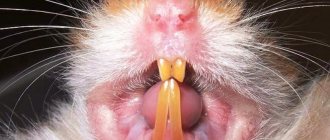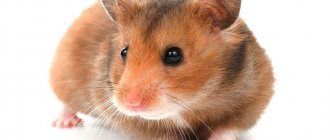Rabies in hamsters is something out of science fiction. The possibility of transmission of rabies to humans from a rodent seems completely impossible. The route of transmission of the virus is too specific. But the disease is incurable and is 100% fatal , so it would be wrong to ignore even the ghostly possibility of infection.
The rabies virus multiplies in the cells of the nervous system and causes specific inflammation of the brain.
Infection is possible only through direct contact, if the saliva of a sick animal gets into the wound or onto the mucous membrane.
The virus travels along the nerves from the wound to the brain. The death of nerve cells causes a variety of neurological disorders. Death occurs from paralysis and suffocation (breathing stops).
The question of whether hamsters get rabies is not entirely correct. Any warm-blooded animal is susceptible to the virus if infected, even birds. The disease is also deadly for humans, hence the natural interest in whether rabies occurs in hamsters. These rodents are the most common pets, and quite often hamsters bite their owners. If a hamster bites a child until the child bleeds, parents want to understand whether any specific therapy is required.
What to do if a child is bitten by a hamster?
Can a child get rabies from a hamster bite?
What can you get infected from a pet bite? Can hamsters spread diseases to children? What to do if the wound bleeds after a hamster bite? Do I need stitches in this case? We answer the main questions. Hamsters are one of the most popular pets for children. According to statistics, a child will be bitten by his or her pet at least once. Most often, such bites are not dangerous; they do not even leave marks. But sometimes rodents dig their sharp teeth deep into the skin, which leads to a bleeding wound. There is no need to worry, just disinfect the injury and cover it with a band-aid.
Toxoplasmosis
The causative agent of the disease is a microscopic parasite. The harmful organism may be in the hamster's saliva. Infection can occur:
- through animal bites;
- through wool. Toxoplasma enters the human body after stroking a pet;
- Rodent excrement is dangerous. You need to wear gloves when cleaning the animal's cage.
In domestic animals, toxoplasmosis may be asymptomatic. If there are any changes in your hamster's behavior, you should contact your veterinarian.
The disease poses the greatest danger to newborns, as it can be transmitted from a pregnant woman to her child.
In this case, the child may experience congenital pathologies of the development of the central nervous system, hydrocephalus, paresis, inflammation of the eyes, paralysis, and disturbances in the functioning of the visual organs.
How to avoid a hamster bite?
Hamsters are harmless, but very sensitive and timid creatures.
If they bite, it is only in self-defense. Therefore, it makes no sense to punish an animal for an accidental incident.
When choosing a hamster, pay attention to its habits. Active hamsters can bite, unlike calm individuals. Generally, males are friendlier than females, and some small breeds are more prone to biting.
Article on the topic: Who is better: a hamster or a rat, differences from a rabbit, chinchilla and parrot
It is important to note that tame hamsters are less likely to bite. Rodents from pet stores are unlikely to be handled, so they are usually hostile. If you are adopting an animal from a shelter, take a closer look at the living conditions. Caring behavior never leads to aggression. Showing affection and kindness to your pet guarantees successful coexistence.
Choriomeningitis
In hamsters the disease has no obvious symptoms. In some cases, there may be a decrease in activity and weight loss. But choriomeningitis poses a serious threat to human health.
This virus can cause encephalitis, meningitis, complex swelling of the lymph nodes, and symptoms of acute rotavirus infection.
The chances of recovery with proper treatment are high. Fatalities are extremely rare. Infected rodents spread the virus through saliva, urine and feces.
Choriomeningitis can also be transmitted from a pregnant woman to her child. The virus can cause miscarriage, stillbirth, hydrocephalus and developmental defects.
What diseases do hamsters carry?
A hamster can be a carrier of some diseases.
Tularemia
is a bacterial infection often called rabbit plague. This disease is very rare and the risk of contracting it through a hamster bite is very low.
Lymphocytic fever choriomeningitis
- a viral infection that can be transmitted through the saliva of a hamster. At risk are:
people with weakened immune systems;
children under 3 years of age.
Hantavirus
- a viral infection, the first symptom of which is sweating. This is a fatal disease. A rodent is more likely to become infected if it lives on the floor in the basement of the house and comes into contact with mice or rats. But even in this case, the chances that the hamster poses a threat are small.
If a child is not vaccinated against
tetanus
and is bitten by a hamster, then a preventive vaccination should be given.
In any case,
the likelihood of contracting any of the listed infections is extremely low.
And in order not to worry again, your pet can be taken to the veterinarian for examination.
Statistics
Rabies is a natural focal disease. The virus circulates in wild animal populations; rabies is most often transmitted by wolves, foxes, and raccoons. Isolated cases of the disease are regularly detected in rodents (rat, hamster, squirrel). There are regions that are officially unaffected by this terrible infection; information can be obtained at the veterinary station or on the Rosselkhoznadzor website.
It cannot be said that hamsters do not have rabies, since isolated cases occur in world practice. Sometimes infected rodents bit their owners.
In Russia - an episode in Novosibirsk, 2003. A hamster bought at a pet store died after biting an 8-year-old child. We bought the rodent in July, it fell ill and died in September. Rabies was confirmed posthumously in the laboratory and by an official examination.
In September 2006, in Belarus (Cherven near Minsk), a 12-year-old girl was bitten by a rabid hamster. The rodent purchased at the market in Zhdanovichi died 2 days after the incident. The examination revealed rabies. Fortunately, the child began a course of vaccinations without waiting for test results, so the girl survived.
March 2012, Ukraine, Zhitomir. Three hamsters purchased at a poultry market died of rabies 10 days after purchase. Three children (1, 5 and 9 years old) were hospitalized for a course of rabies vaccine.
In March 2021, again in Belarus (Kalinkovichi), a hamster dies after biting a 19-year-old owner. The examination confirms rabies.
The cases are rare, but they serve as a reason to begin developing a rabies vaccine for rodents. While such a drug does not exist, preventive vaccinations are given only to predators (dogs, cats, ferrets).
Why is a hamster dangerous?
The question - why are hamsters dangerous may seem stupid and even funny to many people. After all, most people consider these cute rodents harmless and peaceful. But few people know that small pets are susceptible to various infectious diseases. Is it possible to become infected with any disease from a hamster and how to properly maintain these furry animals in order to protect yourself and all household members from infection?
Article on the topic: How to distinguish a Campbell's hamster from a dwarf hamster by external signs
Lichen
The causative agent of the disease is a pathogenic fungus. Hamsters can be carriers of ringworm and shingles, which can be transmitted to humans.
In domestic rodents, the disease manifests itself with the following symptoms:
- loss of appetite;
- inflammation of the affected skin area;
- rash;
- hair loss;
- the formation of a rough crust on the skin.
Since lichen is quickly transmitted by touching a sick animal, it and all objects that have been in contact with the rodent must be isolated from children and other family members.
Symptoms of the disease do not disappear on their own and require mandatory medical attention.
The course of treatment for lichen in hamsters involves the use of external disinfectants and antifungal drugs.
For internal use, medications are prescribed that restore the body's microflora and strengthen the pet's immunity.
You can treat the affected areas of your pet’s body with medications only using thick gloves.
What can you get infected from hamsters?
Even the most careful care of a miniature pet is not a guarantee that it will remain healthy and active throughout its life. Sometimes an infection can enter the animal’s body from low-quality food or sawdust, which the owner uses as bedding for the pet’s cage.
There are also frequent cases when a rodent enters the house already infected, because most diseases do not manifest themselves in the early stages and people do not even realize that their pet is suffering from an infectious disease.
But not all hamster diseases are dangerous to humans. There are only a few infectious diseases that can be contracted from these furry rodents:
- Hamsters are susceptible to such a serious and dangerous disease as tuberculosis , which is transmitted by airborne droplets. Therefore, with prolonged contact with a sick animal, the owner has a considerable risk of contracting tuberculosis;
- Not only cats are carriers of toxoplasmosis , you can also get this disease from hamsters. Toxoplasmosis is especially dangerous for pregnant women, so during this period they need to stop any contact with pets;
- A miniature pet can also infect its owner with listeriosis , a disease that affects the human nervous system. An animal affected by this disease begins to have problems with coordination of movements and balance, which is especially noticeable when the pet runs in a wheel or a maze;
- Among the dangerous diseases that can be transmitted from a hamster to a person are lymphocytic choriomeningitis . You can determine that a rodent is suffering from this disease by the following symptoms: the animal becomes lethargic, refuses to eat, and its limbs are shaken by convulsions;
- Tularemia is another potentially dangerous disease for humans that is transmitted by rodents, including hamsters;
- These animals are also susceptible to dermatological diseases, such as ringworm or dermotoxicosis , which the owner can contract through contact with a sick pet.
Article on the topic: Allergy to hamsters in children and adults, symptoms
Symptoms
If your region of residence is unfavorable for this terrible disease, it is better to find out in advance what the signs of rabies are in hamsters.
Rabies is always characterized by unusual animal behavior, and this is not always aggression. Mad foxes can be affectionate, lose their fear of humans, and lick their hands. The hamster simply loses orientation in space, constantly wandering around the cage without a clear goal. Appetite is absent or distorted (eating inedible objects). The rodent is worried, squeaks, and sometimes shows aggression.
At the final stage of the disease, paralysis of the pharynx causes the inability to take food and water, as well as profuse salivation. Before death, the animal falls into a coma and convulsions are observed.
Symptoms of rabies in hamsters can be vague, in such cases the owners say that the rodent died suddenly. Usually the animal dies no later than a week from the moment of brain damage.
Are hamsters dangerous for children?
Parents do not always decide to buy a dog or cat for their child, fearing that the animal may harm him. And, as an alternative, they buy Djungarian or Syrian hamsters for their children, believing that miniature rodents do not pose a danger to children.
But before giving their baby a hamster, parents should weigh their decision, since these animals are not always harmless and harmless.
If a child is under five years old, it is not recommended to purchase a hamster as a pet. After all, despite the fact that these cute creatures are quite friendly, they can bite the baby if he frightens them or accidentally hurts the animal. Such bites are dangerous because the wound can become inflamed due to an infection that has entered it if the affected area is not treated with an antiseptic in time.
Rodents are also carriers of various parasites, such as helminths, and can infect a child with them.
After contact with a pet, small children do not always wash their hands and put dirty fingers in their mouths, which increases the risk of contracting parasites.
A miniature dwarf or fluffy Syrian hamster will be an ideal pet for school-age children . The child will not only gain a great friend, but will also learn responsibility while caring for this cute creature.
Caring for a sick pet
During illness, in addition to treatment, the Djungarian hamster needs the care and attention of the owner.
Maintaining the right microclimate
The cage with a sick Djungarian hamster should be placed in a quiet room. It is important to protect it from direct sunlight and drafts. The room should not be too hot or cold. The suitable temperature for keeping a rodent is +22…+25 degrees.
Due to general malaise, the hamster's body temperature may drop. A heating pad or a bottle of warm water will help warm it up. It needs to be placed in a cage and covered with a towel. You can put your pet on it for the first time. When he feels the source of heat, he himself will understand that he needs to stay closer to it.
Maintaining water balance
If a sick dzhungarik refuses to eat and drink, this threatens dehydration. Perhaps the pet does not have the strength to approach the drinking bowl. In this case, he needs help - move the container with water closer to the place where the animal lies.
If this does not help and the hamster does not drink on its own, then you will need an insulin syringe without a needle. You need to fill it with clean water, squeeze out a drop and touch the animal’s tongue so that it licks it. Under no circumstances should you pour liquid into the mouth - the hamster may choke. Another way to give water to a sick pet is to wet the fur near the lips. He will immediately begin to wash himself and lick the water.
Hygiene
When your Djungarian hamster is sick, it is important to keep the cage clean. In order not to disturb him once again, the litter is cleaned in a targeted manner. Places of heavy contamination are removed with a spoon. This is done daily, as the fumes from hamster droppings are very harmful. They contain high concentrations of ammonia and hydrogen sulfide.
Limiting stress factors
During illness, the dwarf needs complete rest. Stress is deadly even for a healthy rodent. Therefore, it is important to protect him from anything that could frighten the baby. It is best to place the cage in a separate room and limit access to other pets and children. While the animal is sick, you should not move its home from place to place.
Can cats or dogs get the disease from a hamster?
If there are other animals in the house besides hamsters, then the owners are concerned about the question of whether rodents can infect a cat or dog with something.
There is no need to be afraid that a kitten or puppy will catch an infectious disease from a domestic rodent. All diseases to which these animals are susceptible are not dangerous to other pets.
Even if a cat eats a rabies-infected hamster, it will not become infected with this dangerous disease, since the rabies virus is transmitted through a bite. The exception is if the cat had open wounds in its mouth and the blood of a sick rodent got into them.
Article on the topic: How to determine the sex of a hamster and distinguish a boy from a girl, males and females of the Dzungarian and Syrian breeds
Disadvantages in content
Like every animal, a hamster has its own characteristics and character. In addition to the many advantages of keeping this pet, there are also a number of disadvantages that may discourage a person from purchasing this rodent.
These disadvantages include:
- hamster activity at night;
- unpleasant odor;
- the animal can bite;
- short lifespan.
Some of these problems can be solved by changing or improving the pet's living conditions. Additionally, your pet's thick fur may cause an allergic reaction in some people.
nocturnal animal
The hamster by nature prefers to sleep during the day and becomes more active in the dark. For some people this may be a problem, since the animal is very energetic when awake: it runs around the cage, plays and makes noise. In this case, it is better not to place the cage in the bedroom or room for night rest. If your hamster sleeps during the day, you should not wake him up. Disruption of his daily routine can negatively affect both the mood and well-being of the pet.
Important! For owners of one-room apartments, it is recommended to move the cage at night away from the sleeping area. In this situation, it is recommended to place the house in the kitchen or in the hallway.
Unpleasant smell
Often, hamster owners complain about the stench from the cage. In this case, it is necessary to understand its source.
An unpleasant odor can come from:
- cells;
- animal.
The first case is considered the most common. If a rodent lives in hay, paper or fabric, then moisture is poorly retained in such materials, which is why an unpleasant odor is formed over time. Sawdust, cellulose or corn filler can partially solve this problem. Each of these materials has its own service life. For example, it is recommended to change sawdust every 3-4 days, and corn filler - every 7-10 days.
Prevention measures: how to prevent infection
To protect yourself and your loved ones from contracting infectious diseases carried by hamsters, you should remember a few basic rules when keeping them:
- It is advisable to purchase a furry pet only from breeders or pet stores with a good reputation. When buying an animal on the market, the owner risks purchasing an animal infected with infection;
- When choosing a hamster, it is recommended to pay attention to its appearance and behavior. Sick hamsters have dull, sloppy fur, bloodshot eyes, and act lethargic and lethargic;
- It is necessary to monitor the cleanliness of your pet’s home and remove dirty litter in a timely manner. This way, the owner will not only get rid of the unpleasant odor from the cage, but will also reduce the risk of infection entering the animal’s body;
- The rodent should be fed only high-quality food. Stale and rotten grains can cause various diseases in hamsters;
- When cleaning the cage, the owner should always wear gloves, since infection can be spread not only through contact with the animal, but also through its feces.
You should not give up the pleasure of communicating with a miniature fluffy hamster just because there is a possibility of contracting some disease from it. After all, if you properly care for and care for a small creature and pay enough attention to it, then the funny animal will always delight the owner with activity, health and well-being.
Preventive measures
To ensure that hamsters do not transmit diseases dangerous to humans to their owner, certain rules should be followed. These include:
- balanced nutrition for pets;
- the use of vitamin-mineral complexes in their diet;
- absence of drafts in the place where the cage is installed;
- Carrying out frequent cage cleaning and disinfection measures;
- use of disposable rubber gloves during daily inspections of animals and during cleaning.
It is extremely important to monitor the condition of your hamster. If he loses his appetite, pus appears in his eyes, diarrhea, there is weight loss, he becomes restless, his fur begins to fall out or become matted and hang in clumps, most likely something is wrong with him. At the first signs of poor health, the animal must be taken to the veterinarian.
What can you get infected from hamsters?
Miniature creatures are carriers of several infections transmitted to humans.
Article on the topic: What is needed for a hamster: a list of things necessary for the appearance of a pet in the house
The main diseases of hamsters dangerous to humans:
- Listeriosis is a disease that negatively affects the nervous system of animals and humans. In the initial stages there are no symptoms.
The main signs of a pet infection:
- Loss of balance when running.
- Apathy and drowsiness.
- Deterioration or lack of appetite.
- Fever.
At an early stage, listeriosis is easily treatable. In severe cases, the disease leads to the death of the pet.
The causes of infection are:
- Poor nutrition.
- Violation of the temperature regime in the cage.
- Insufficient home hygiene and improper care.
- Toxoplasmosis is a disease that poses a particular danger to pregnant women. The entry of infection into the body of a pregnant woman causes various pathologies of the fetus. In addition to hamsters, you can become infected with toxoplasmosis through contact with a cat or raw meat. Transmitted through pet feces and secretions.
- Tuberculosis is a dangerous disease of the respiratory tract. A pet can become infected by airborne droplets from humans.
Symptoms do not appear immediately. At first the animal seems absolutely healthy. The disease is manifested by loss of appetite, rapid weight loss and apathy. It is quite difficult to cure a hamster from tuberculosis. In most cases, it dies within a few days.
- Tularemia is a disease that affects the lymph nodes, skin and other parts of the body. It is asymptomatic. Your hamster can become infected through contaminated water or food. The disease is transmitted to humans through physical contact. Sick animals are euthanized and the premises are thoroughly disinfected.
- Ringworm affects the skin of the body.
Main symptoms of the disease:
- Hair loss.
- Formation of a crust on the affected areas.
- Itching.
- Anxiety.
When transporting the animal, it is recommended to use gloves and disinfect the room, cage and objects with which the hamster has been in contact.
- Parasites are common sources of disease. Transmitted through unprocessed food and low-quality fillers. A person can become infected through physical contact with an animal.
Diagnosing parasites at home is difficult. Symptoms are often similar to other diseases.
- Lymphocytic choriomeningitis affects the brain and blood vessels of the rodent. The disease is manifested by apathy, lack of appetite and convulsions. The disease is dangerous for humans.
- Various diseases of the gastrointestinal tract.
Article on the topic: How to determine the age of Djungarian and Syrian hamsters
Most diseases are transmitted from hamsters to humans through physical contact. Before getting a pet, it is important to know what you can get from a hamster.
Lesions causing disturbances in the functioning of the gastrointestinal tract
The main disorders of the human gastrointestinal tract transmitted from hamsters are:
- salmonellosis – characterized by severe intoxication of the human body;
- campylobacteriosis – accompanied by disruption of the stomach;
- hymenolepidosis – characterized by convulsive, fainting states, dizziness, nausea.
The causes of the development of such diseases in animals are:
- unsanitary conditions of detention;
- constant contamination of feed;
- rare change of filler.
Can cats or dogs get the disease from a hamster?
How dangerous are hamsters for other pets? The presence of infectious diseases in rodents is not a cause for concern for owners of cats, dogs and other animals. In most cases, the disease is not transmitted to other animals. The exception is mixing the blood of a healthy and sick animal. The situation is possible if there are wounds.
It should be remembered that cats and dogs are also carriers of various diseases. It is necessary to take care of the health of all pets.
Listeriosis
The disease often occurs in rodents and can greatly harm human health. It can occur in latent, acute and chronic forms.
Hamsters can acquire the infection from food, and the disease is transmitted to humans by airborne droplets.
An affected rodent will experience a loss of balance. Listeriosis is diagnosed by clinical studies, which indicate changes in blood composition and enlarged lymph nodes.
Signs of an acute form of the disease include:
- increased body temperature;
- swollen eyelids;
- loss of appetite;
- cough;
- disheveled wool;
- rapid breathing.
With timely medical care, your pet can recover and return to a full life.
Infectious diseases
Tuberculosis
Tuberculosis is a well-known dangerous disease that can also affect pets, including hamsters. caused by the tuberculosis bacillus. The pathological process can develop anywhere in the body, but more often it is a pulmonary form, since the pathogen usually enters the body with air. Sick hamsters may seem relatively healthy for a long time. At the final stage, the animal becomes inactive, loses weight and dies.
Listerosis
It is also a dangerous disease for humans, common among rodents. For a long time it may hardly manifest itself. The first symptom is an imbalance in the hamster during active movement. This is more noticeable when he is running through the maze. Listerosis occurs in two types: acute and asymptomatic forms (carriage of the pathogen).
Toxoplasmosis
A very dangerous disease for pregnant women . Can cause severe fetal malformations. Any pet (especially cats) can be carriers; infection also occurs through poorly cooked meat. It is important to note that usually, almost all cat owners experience this disease asymptomatically, even before pregnancy, however, if you have never kept animals in the house, contact with them during pregnancy is strictly prohibited.
Toxoplasma is released into the environment through feces and other secretions.
Ringworm
An unpleasant and dangerous disease of hamsters and other domestic animals. The main obvious symptoms are the loss of areas of hair, the formation of crusts on the skin and the animal scratching the affected areas. The animal behaves restlessly.
Tularemia
A very dangerous disease for people. Other animals can become infected through food or contact with already infected diseases.
Causes of aggression in hamsters
If a hamster bites, it did it for a reason. External factors provoked the animal’s aggression. Therefore, the Dzhungarik or representatives of other breeds instinctively defend themselves.
The causes of aggression and biting in a hamster are:
- The instinct of self-preservation. Pregnant or already given birth females are prone to aggression. They protect their offspring. It is not recommended to handle them or the cubs.
- The smell of food from human hands. The hamster smells a new smell and wants to know the taste. Such bites are usually shallow and isolated.
- Fright. Hamsters get scared if you suddenly grab them from above by the back. They may be in pain or scared, it is unclear what is happening. In such a case, they can bite a person repeatedly.
- Sudden movements, loud shouts or too active actions during play can frighten the rodent.
Another cause of hamster bites is tooth grinding . Their incisors and front teeth are sharp and long. Teeth grow throughout the pet's life. Therefore, it is important to ensure that the rodent has the opportunity to grind them down. For this purpose, stones and branches of some fruit trees are used. Root parts of plants, hard pieces of bread, and crackers are suitable for this.
Prevention measures
Don't be afraid to have cute creatures. Any infection can be prevented. To avoid infection, it is important to follow the basic rules of maintenance and care:
- Monitor the animal's diet. Use only proven feed and products.
- Add vitamins and minerals to your food. This measure strengthens the hamster's immunity and maintains health.
- Observe temperature conditions. Avoid overcooling the animal, excessive dampness and drafts.
- Clean the cage daily. Disinfect periodically.
- When cleaning and performing routine inspections of the animal, wear rubber gloves.
- If warning signs appear, it is recommended to consult a doctor immediately.
Unfortunately, a hamster can also catch a cold from a person. If the owner is a carrier of the virus, contact can transmit the disease to the animal. To prevent infection, it is recommended to take measures to protect the animal or limit contact during illness.
Diseases of the genitourinary system in hamsters
Cystitis in a hamster
Cystitis in a hamster is a disease that affects the genitourinary system
- Causes - The causes of cystitis can be both mechanical damage and nutritional disorders. It is also possible that the disease may appear due to the lack of the proper amount of water in the diet;
- symptoms include frequent urination and increased anxiety;
- treatment is carried out by using drugs such as buscopan. If after a course of taking medications the condition does not improve, it is necessary to re-diagnose using x-rays.
This is a solitary animal
Hamsters in the wild lead a solitary lifestyle. They dig deep holes and desperately defend them even from their own relatives, not to mention representatives of other species.
Therefore, hamsters are not at all happy to communicate with a person, especially if we are talking about a child who behaves quite noisily, because he cannot contain his delight at the sight of a cute fluffy animal that looks so much like a plush toy.
Hamsters perceive communication with humans as severe stress, especially considering that these animals are very shy.
What could be the danger?
A hamster bite is not dangerous, since cases of rabies being transmitted by these animals have not been recorded. But they may suffer from other ailments. If a rodent that has bitten a person gets sick, dies, or if abscesses, itching, redness, or a swollen finger appear at the site of the bite, consult a doctor. It doesn't hurt to be vigilant if a hamster bites a child.
Weaning the habit of biting
Parents may begin to panic, giving in to which they do not know what to do if a hamster bites a child. After the wound is disinfected and the “woolen robber” is sitting in the cage, you need to discuss the situation with the child. Explain that teeth are the only way of defense, and a bite is a reaction to careless handling.
The bites may continue until you tame the rodent and begin to treat it affectionately. In rare cases, the animal's temperament is so aggressive that the hamster may bite for no reason. In such cases, you need to be patient and slowly but surely tame the rodent.
To wean your hamster from biting, treat him with a treat - put his favorite treat in the cage, but don’t remove your hand, let him sniff it and remember the smell. The next step is to offer food from your hand. You can start petting the animal after it has learned to eat from your hand.
A hamster that is accustomed to hands will allow itself to be taken out of the cage, it will like to sit on your hand, but it is unlikely to allow itself to be squeezed and bites until it bleeds may be repeated.
Important! If the animal is not vaccinated or a hamster bite for some reason causes you anxiety, go for a consultation with a doctor. Most likely, he will prescribe an ointment for inflammation.
According to doctors, these animals carry salmonella and meningitis. In practice, infection is unlikely.
A rodent bite resembles a regular wound and heals quickly. Rarely, there is a slight increase in temperature, the wound abscesses and swells. This is evidence of infection.
Important: even if a hamster bites until it bleeds, it cannot infect its owner with rabies or tetanus if it has not been in contact with an infected animal.
For a child, a wound from a rodent's teeth is more dangerous than for an adult, since children scratch them, opening access to bacteria, and cannot independently treat the affected area and tell their parents about it in time.
The biting hamster is ashamed
If a hamster has harmed a child, you need to observe both the child and the animal for some time: are both healthy and cheerful? You have no reason to worry. Hamsters most often bite children, this is due to the fact that children spend more time with animals: they want to play with them, while the animals go to bed, they do not always understand that a little fluff is a living creature. The animal's self-preservation instinct wins and the hamster is forced to bite the offender.
If the hamster is well-fed, rested, and in a good mood, he will never bite his owner and will happily sit in his palm.











